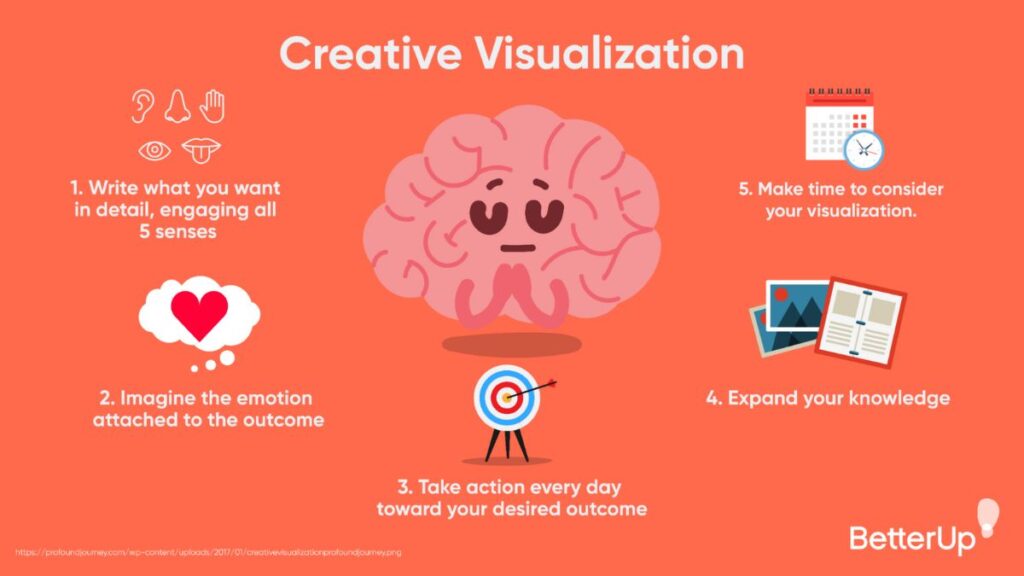Motivation is the driving force that propels us toward achieving our goals, whether they are personal, professional, or academic. However, many individuals struggle to maintain high levels of motivation, especially when faced with challenges and setbacks. One powerful method to enhance motivation is through visualization techniques. Visualization involves creating a mental image of a desired outcome, allowing individuals to mentally rehearse their goals and the steps needed to achieve them. This article delves into various visualization techniques, their psychological basis, and how to effectively implement them to boost motivation.
Understanding Visualization Techniques
Visualization techniques harness the power of the mind to create vivid images of success, enhancing motivation by making goals feel more attainable. This practice is rooted in cognitive psychology, which suggests that mental imagery can stimulate the same brain areas that are activated during actual performance. When individuals visualize achieving their goals, they experience a heightened sense of self-efficacy, which significantly influences their motivation levels.
The core principle behind visualization is the concept of “mental rehearsal.” Just as athletes visualize their performances before competitions to enhance their readiness, anyone can benefit from mentally picturing their goals and the steps needed to achieve them. This technique not only clarifies goals but also helps in identifying potential obstacles and strategizing ways to overcome them, further solidifying motivation.
The Psychological Basis of Visualization
Several psychological theories support the efficacy of visualization techniques. One prominent theory is Albert Bandura’s social cognitive theory, which emphasizes the role of self-efficacy in motivation. Self-efficacy refers to an individual’s belief in their ability to succeed in specific situations. Visualization can significantly enhance self-efficacy by providing a mental framework for success, thereby motivating individuals to take action.
Additionally, the concept of “neuroplasticity” plays a crucial role in understanding why visualization works. Neuroplasticity refers to the brain’s ability to reorganize itself by forming new neural connections throughout life. When individuals repeatedly visualize their goals, they strengthen the neural pathways associated with those goals, making them more likely to pursue them in reality. This process not only enhances motivation but also improves focus and determination.
Types of Visualization Techniques
There are various visualization techniques that individuals can use to increase motivation. Each technique can be tailored to fit personal preferences and specific goals.
1. Outcome Visualization
Outcome visualization involves picturing the successful completion of a goal. For example, if your goal is to run a marathon, you might visualize crossing the finish line, feeling a sense of accomplishment and joy. This technique helps individuals connect emotionally with their goals, which can significantly enhance motivation. The more vivid and detailed the visualization, the more effective it becomes. Imagine the sounds, sights, and even smells associated with achieving your goal to make the experience as real as possible.
2. Process Visualization
Process visualization focuses on the steps required to achieve a goal rather than the outcome itself. For instance, using the marathon example again, process visualization would involve picturing yourself training, setting your running schedule, and overcoming challenges along the way. By visualizing the journey, individuals can prepare mentally for the obstacles they may face, increasing their resilience and motivation to keep moving forward.
3. Daily Visualization Practice
Incorporating visualization into your daily routine can be a powerful way to boost motivation. Set aside a few minutes each day to practice visualization. Find a quiet space, close your eyes, and imagine yourself engaging in activities that align with your goals. This practice not only reinforces your commitment to your goals but also helps in reducing anxiety and increasing focus.
4. Vision Boards
Creating a vision board is a tangible way to visualize your goals. A vision board is a collage of images, words, and quotes that represent your aspirations. By displaying it in a prominent location, you can reinforce your goals daily. The act of curating a vision board can also spark motivation, as it allows individuals to reflect on their desires and visualize their future.
5. Guided Visualization
Guided visualization involves using audio recordings or scripts to lead you through a visualization process. This technique can be particularly effective for those who find it challenging to visualize on their own. Guided sessions often include relaxation techniques, which can enhance the effectiveness of the visualization. Many resources are available online or through apps to assist with guided visualization practices.
Implementing Visualization Techniques in Daily Life
Integrating visualization techniques into your daily life requires intentionality and practice. Here are some strategies to help you get started:
1. Set Clear Goals
Before you can effectively visualize your success, it’s essential to set clear, specific goals. Vague goals lead to vague visualizations. For instance, instead of saying, “I want to get fit,” specify, “I want to run a 5K in under 30 minutes.” Clear goals provide a solid foundation for your visualization efforts.
2. Create a Routine
Incorporate visualization into your daily routine. Whether it’s in the morning, during a lunch break, or before bed, find a time that works for you. Consistency is key to reinforcing the mental images and increasing motivation. Make it a part of your self-care or mindfulness practices to enhance its effectiveness.
3. Combine with Affirmations
Pairing visualization with positive affirmations can amplify its impact. As you visualize your goals, repeat affirmations that align with your aspirations, such as “I am capable of achieving my goals” or “I have the determination to succeed.” This combination fosters a positive mindset, enhancing motivation and self-belief.
4. Stay Positive
Visualization works best when it is rooted in positivity. Focus on the excitement and joy associated with achieving your goals rather than potential failures or setbacks. Maintaining a positive outlook can help create a more motivating visualization experience, making it easier to stay committed to your aspirations.
5. Track Your Progress
Keep a journal or use apps to track your progress toward your goals. Documenting your achievements can reinforce your visualization efforts and provide motivation when you encounter obstacles. Reflecting on how far you’ve come can reignite your passion and commitment to your goals.
Overcoming Common Challenges
While visualization techniques are powerful, individuals may face challenges when trying to implement them. Here are some common obstacles and strategies to overcome them:
1. Difficulty Visualizing
Not everyone finds it easy to create mental images. If you struggle with visualization, start small. Instead of trying to visualize an entire goal, focus on specific aspects or emotions associated with it. Over time, as you practice, your ability to visualize will improve.
2. Skepticism
Some individuals may feel skeptical about the effectiveness of visualization. It’s important to remember that visualization is a tool, and its impact can vary from person to person. Approach it with an open mind and give yourself time to experience its benefits before dismissing it.
3. Negative Thoughts
Negative thoughts can undermine the effectiveness of visualization. Combat negative self-talk by acknowledging it without judgment, then redirect your focus to positive affirmations and visualization. Regular mindfulness practices can also help in managing negative thoughts.
Conclusion
Visualization techniques are a powerful and effective way to increase motivation. By harnessing the mind’s ability to create vivid mental images of success, individuals can enhance their self-efficacy, clarity, and resilience in pursuing their goals. Whether through outcome visualization, process visualization, or creating vision boards, incorporating these techniques into daily life can lead to significant improvements in motivation.
As you embark on your journey to boost motivation through visualization, remember to set clear goals, create a consistent routine, and remain positive. Overcoming challenges may take time, but with practice, visualization can become a valuable tool in your motivational toolkit. By effectively using visualization techniques, you can transform your dreams into achievable realities, propelling yourself toward success.





